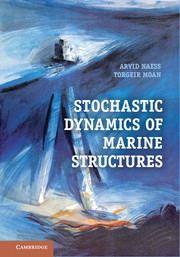Book contents
- Frontmatter
- Contents
- Preface
- 1 Preliminaries
- 2 Dynamics of Single-Degree-of-Freedom Linear Systems
- 3 Dynamics of Multi-Degree-of-Freedom Linear Systems
- 4 Finite Element Method
- 5 Stochastic Processes
- 6 Variance Spectrum
- 7 Environmental Loads
- 8 Random Environmental Processes
- 9 Response Spectrum
- 10 Response Statistics
- 11 Statistics for Nonlinear Problems
- 12 Short-Term and Long-Term Extremes
- 13 Dynamic Load Effects for Design Checks
- 14 Equations of Motion
- 15 Numerical Solution Techniques
- 16 Monte Carlo Methods and Extreme Value Estimation
- A Integrals
- B Poisson Process
- C Statistical Moments and Cumulants
- References
- Index
8 - Random Environmental Processes
Published online by Cambridge University Press: 05 February 2013
- Frontmatter
- Contents
- Preface
- 1 Preliminaries
- 2 Dynamics of Single-Degree-of-Freedom Linear Systems
- 3 Dynamics of Multi-Degree-of-Freedom Linear Systems
- 4 Finite Element Method
- 5 Stochastic Processes
- 6 Variance Spectrum
- 7 Environmental Loads
- 8 Random Environmental Processes
- 9 Response Spectrum
- 10 Response Statistics
- 11 Statistics for Nonlinear Problems
- 12 Short-Term and Long-Term Extremes
- 13 Dynamic Load Effects for Design Checks
- 14 Equations of Motion
- 15 Numerical Solution Techniques
- 16 Monte Carlo Methods and Extreme Value Estimation
- A Integrals
- B Poisson Process
- C Statistical Moments and Cumulants
- References
- Index
Summary
Introduction
The focus of this chapter is on ocean waves and wind, modeled as random processes (or random fields). The ocean climate is continuously changing, implying that the wave and wind processes are nonstationary in the long run, even on the time scale of hours. However, for modeling purposes, it is common practice to assume that the long term evolution of the wave and wind conditions can be considered as a sequence of 3 hour stationary pieces. This is obviously a simplification, but it is useful and sufficiently accurate for most engineering purposes. The benefit of this kind of modeling is that the tools developed for stationary processes can be used also for long term assessment of the loads and responses of a marine structure. Of particular importance is the possibility to apply the concept of a spectral density (or variance spectrum) for the characterization and representation of the wave and wind processes.
Ocean Waves
Wave Process
The design of structures to withstand the impact of environmental forces such as wind and ocean waves, typical of ships and ocean structures, has to invariably take into account the irregular or random nature of these kinds of loads. The standard approach to the statistical modeling of ocean waves is to assume that the ocean surface constitutes a stochastic wave field that can be assumed stationary in time and homogeneous in space. However, in engineering practice, stationarity is assumed only for limited periods of time, like three hours, which is then referred to as the short-term description of the wave field. This says that we are assuming steady-state wave conditions for specified intervals of time with no transition periods between different sea states. This is clearly an approximation, but it seems to work well for most offshore design applications.
Information
- Type
- Chapter
- Information
- Stochastic Dynamics of Marine Structures , pp. 191 - 208Publisher: Cambridge University PressPrint publication year: 2012
